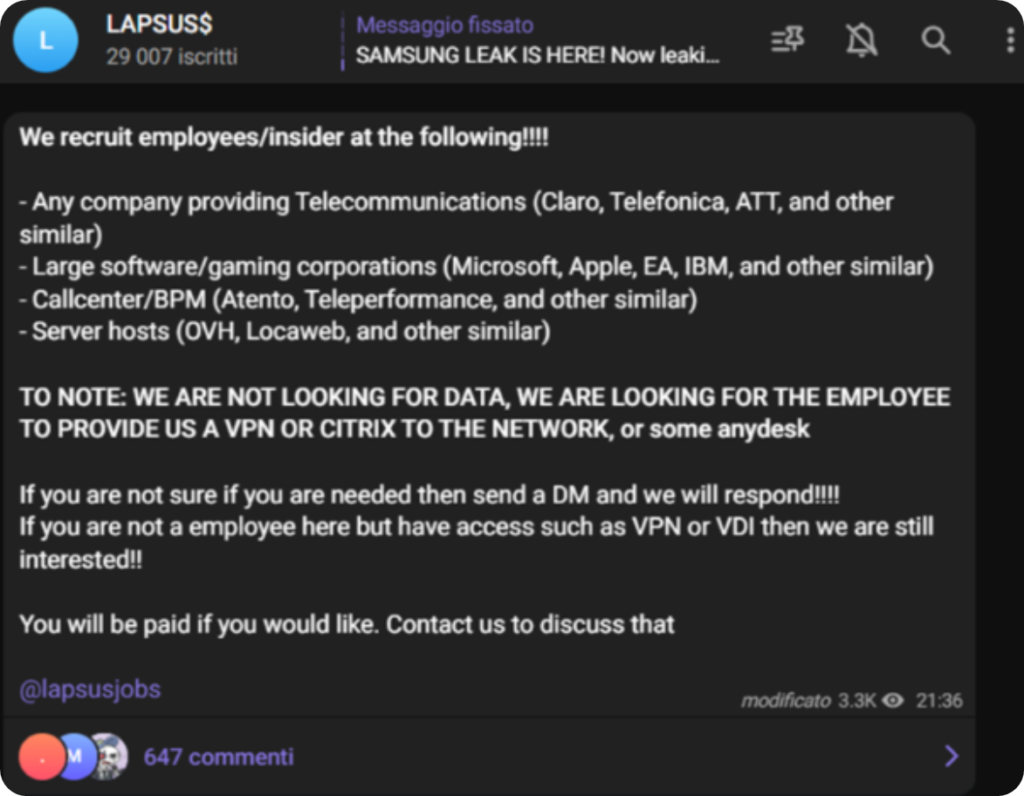
In the digital age, cybersecurity is a critical issue for any company handling sensitive data. However, not all risks are external. In fact, employees themselves often pose a threat to an organization’s cybersecurity.
They’re called “rogue employees.” These are company employees who want to cause harm to the company, perhaps for their own gain, and they represent a threat that organizations must deal with today.
In this article, we’ll explore who disloyal employees are, what motivates them, what their effects are, how criminal cyber gangs recruit them, and how mitigations and psychological factors influence their behavior.
A disloyal employee is an employee who commits illicit actions against the company’s IT security for various reasons, which we’ll explore in the next article. chapter.
These behaviors can include unauthorized access to data, copying or selling confidential information, installing malicious software, and much more.
Disloyal employees pose a significant threat to a company’s cybersecurity because they have access to confidential information and can use their knowledge to circumvent security measures. Furthermore, cheating employees are often difficult to detect because they already have access to the data.
Motivations of cheating employees include lack of job satisfaction, professional ambition, the pursuit of extra income, or personal revenge. In some cases, disloyal employees may act for ideological or political reasons.
Lack of job satisfaction can lead employees toseek new job opportunities or become disillusioned with the company. In some cases, disloyal employees may act out of revenge, such as discrimination or retaliation against employees.
Professional ambition may lead employees to seek extra money or acquire confidential information to advance their professional careers. In some cases, disloyal employees may also be motivated by financial reasons, such as the desire to sell confidential information to third parties such as their clients or intellectual property, thus undermining the organization’s efforts.
Personal revenge is a common motivation for disloyal employees, who may act against the company or their superiors following internal conflicts, discrimination, or retaliation against employees. In some cases, disloyal employees may act for ideological or political reasons, such as to sabotage the company or leak confidential information.
The actions of disloyal employees can cause financial and reputational damage to the company, as well as the loss of sensitive data and the violation of customer privacy.
Furthermore, the effects of disloyal employee actions can last a long time. For example, the loss of sensitive data or the breach of customer privacy can have long-term consequences for a company’s reputation and its ability to maintain customer trust.
Managing the risks associated with the actions of rogue employees is a priority for any company wishing to protect its cybersecurity and business objectives.
Numerous cybergangs, including LockBit and Lapsus, have used rogue employees to gain information useful for hacking into companies’ IT systems. These attackers may attempt to contact the disloyal employees themselves through online communication channels or through their contact networks.

The motivations behind this type of recruitment can be varied. Some cyber gangs may try to infiltrate companies to steal confidential information or, for example, use their computer systems as part of a botnet or to mine cryptocurrency. Others may try to extort money or cause damage to company computer systems.
To prevent the recruitment of disloyal employees, companies must adopt robust security policies and train their employees on how to recognize and report any recruitment attempts, thus building trust between the organization and the employee.

The behavior of disloyal employees in the field of cybersecurity has also been studied from a psychological perspective. Some scholars have attempted to understand the motivations that drive employees to betray the company’s trust and put cybersecurity at risk.
According to experts, the behavior of disloyal employees can be caused by several factors. One of the main ones is a lack of job satisfaction, which can lead employees to seek new job opportunities or feel disillusioned with the company. In some cases, disloyal employees may also be motivated by financial reasons, such as the desire to sell confidential information to third parties or demand a ransom in exchange for data restoration.
Furthermore, employees can be victims of social engineering attacks, in which criminals try to convince them to disclose confidential information or perform actions harmful to the company. These attacks can be particularly effective if employees are not adequately trained in cybersecurity.
In any case, it is important for companies to understand employee behavior to prevent potential cybersecurity incidents. Companies should adopt robust cybersecurity policies and procedures and adequately train employees in cybersecurity. Furthermore, companies should constantly monitor employee activity on company IT systems to identify any suspicious behavior.
Companies must deal with the risk of their employees engaging in unfaithful behavior and jeopardizing the company’s IT security. But there are techniques companies can use to prevent and reduce this risk.
The first technique is to implement robust security policies. These policies should include login and authentication procedures, strong password policies, data monitoring systems, and procedures for managing employee credentials.
Second, employee training is essential to ensure that all employees are aware of the company’s security policies and are able to identify and report any untrustworthy behavior.
Third, the company must constantly monitor employee activity on the company’s IT systems to identify any suspicious behavior. This can be done using activity monitoring and logging systems.
Fourth, companies should limit access to sensitive data to only those employees who need it to perform their jobs (need to know). This reduces the risk of data falling into the wrong hands.
Finally, the company should implement a series of technologies to prevent employee misconduct. These include data encryption, implementing two-factor authentication systems, and using employee activity monitoring tools. In this way, companies can reduce the risk of employee disloyalty and improve the company’s overall cybersecurity.
Disloyal employees, as we have seen, pose a threat to a company’s cybersecurity and can cause significant damage. To prevent these incidents, it is important for companies to adopt robust cybersecurity policies and procedures and adequately train employees on cybersecurity.
However, in addition to technical cybersecurity measures, it is also important to build trust between the organization and its employees. Disloyal employees often act out of feelings of dissatisfaction, frustration, or resentment, which can be avoided through a positive work environment and open communication between the company and employees.
Furthermore, companies should provide anonymous reporting channels for reporting any suspicious behavior or cybersecurity violations, allowing employees to raise potential issues without fear of retaliation.
In summary, preventing cybersecurity incidents caused by disloyal employees requires a holistic approach that includes both technical cybersecurity measures and the creation of a climate of trust and collaboration between the company and employees.
Only by combining these factors can we ensure the organization’s cybersecurity and protect confidential information from insider threats.
Follow us on Google News to receive daily updates on cybersecurity. Contact us if you would like to report news, insights or content for publication.
